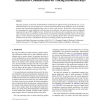Free Online Productivity Tools
i2Speak
i2Symbol
i2OCR
iTex2Img
iWeb2Print
iWeb2Shot
i2Type
iPdf2Split
iPdf2Merge
i2Bopomofo
i2Arabic
i2Style
i2Image
i2PDF
iLatex2Rtf
Sci2ools
EGH
2010
Springer
2010
Springer
Architecture considerations for tracing incoherent rays
This paper proposes a massively parallel hardware architecture for efficient tracing of incoherent rays, e.g. for global illumination. The general approach is centered around hierarchical treelet subdivision of the acceleration structure and repeated queueing/postponing of rays to reduce cache pressure. We describe a heuristic algorithm for determining the treelet subdivision, and show that our architecture can reduce the total memory bandwidth requirements by up to 90% in difficult scenes. Furthermore the architecture allows submitting rays in an arbitrary order with practically no performance penalty. We also conclude that scheduling algorithms can have an important effect on results, and that using fixed-size queues is not an appealing design choice. Increased auxiliary traffic, including traversal stacks, is identified as the foremost remaining challenge of this architecture. Categories and Subject Descriptors (according to ACM CCS): I.3.1 [Computer Graphics]: Hardware Architectur...
| Added | 11 Feb 2011 |
| Updated | 11 Feb 2011 |
| Type | Journal |
| Year | 2010 |
| Where | EGH |
| Authors | Timo Aila, Tero Karras |
Comments (0)

